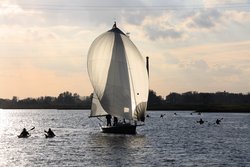Hovership 3DFly drone
3DFLY MICRO QUAD KIT from Hovership.
With this kit http://shop.hovership.com/3dfly-micro-quad-kit/ you can built your one drone. Hoverships website contains a good assembly guide https://web.archive.org/web/20180303204630/http://www.hovership.com/guid.... Building the drone is not very difficult when you have some basic soldering skills. After this step you have to configure the flight controller board and connect it with your transmitter. I couldn't find a website describing how to do this. There is only Beef's Brushed Board User Manual v1.1, but this manual assumes you already know how to use this board. As a complete beginner I had to google a few hours to find all basic information. I created this page to help other beginners.
The Hovership drone uses a flight controller board called Beef's Brushed Board (BBB32). This board contains all drone electronics: gyro, accelerometer and motor control.
The default installed firmware is: Baseflight. This firmware has a lot of configuration options. You will need the USB programmer to connect the board to your pc. To configure the board, you will also need software. I used the Baseflight app from the Chrome webstore in Google Chrome of Chromium. It's a web browser app, which makes it's OS independent. It will work on Windows, Mac an Linux. I was using Linux. The board will be powered by the USB port, so you don't have to connect the battery to the board. Only when testing the motors, you will have to connect the battery. In my case the app automatically connects to the board.
Gyro and Accel are enabled (green), the other functions are not on this board. The Setup tab shows the orientation of the drone. Calibrate it first (put it on a flat surface). After that you can see every small change in orientation of the drone. Now you can change the settings according to Beef's Brushed Board User Manual v1.1. Binding the transmitter to the receiver on the drone is also part of the procedure. Binding is the process of connecting the transmitter and receiver to each other, so they can communicate without interference from other transmitters. The receiver will only accept your transmitter. Read the manual of your transmitter how to put it in binding mode. In my case I also had to connect the battery to the board.
After binding, the transmitter is able to communicate with the receiver. The receiver lights up when it has a connection with the transmitter. In the Receiver tab, select the right Channel Map and test if the transmitter functions (Roll / Pitch / Throttle / Yaw) correspond to the right channels. Also check if the channels are not reversed. Roll and Yaw to the right on the transmitter must also push the bars on the Receiver tab to the right. Moving throttle and Pitch forward must increase the levels on the receiver. If not, reverse the corresponding channel on the transmitter (see transmitter manual).
At the Motor Testing tab, you can test your motors. The battery must be connected for this test.
If everything works, disconnect from the Baseflight app and remove the USB programmer. You can test the drone first without props. Turn the transmitter and drone on. For security reasons, the motors will not be able to spin. The drone must be armed before the throttle on the transmitter can control the motors. Arming can be done to hold the throttle/yaw stick a few seconds to the lower right. The green light will turn on when the drone is armed. To disarm, push the stick to the lower left.
There are right an left spinning props. Install them on the right motors. White on the front side. The arrow on the board points to the front side of the drone.
Now the drone will fly...

